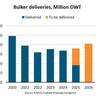Supply Chains Need to Adapt as Power Shifts to Emerging Markets
Over 80% of the world’s population resides in what is known as “emerging markets.” This group of countries represents a diverse collection of economies from China to Peru and Ethiopia to Kazakhstan. Combined, emerging markets have witnessed impressive economic growth over the past few years in comparison to developed economies such as the European Union and the U.S. and present great opportunities for logistics and transportation providers.
As a percentage of global import and export value, emerging markets have expanded their share over the past four years. From 26.1% of total global import value in 2009, emerging markets now comprises almost a third of global import value at 30.8%. For global export value, emerging markets was responsible for 31.0% of global export value in 2009 and has increased its share to 35.8% by 2012.
Ti’s latest report, Global Emerging Markets, takes an in-depth look at this collection of countries. While there are plenty of opportunities in these countries, it is not for the risk-adverse. Political upheavals such as in Egypt, natural disasters as observed in Thailand in 2011 and domestic economic issues in Brazil and India are among the many supply chain risks that must be taken into account.
Even so, demand for logistics services in emerging markets is outpacing that of developing markets. For example, the global contract logistics market grew at 3.4% from 2011 to 2012 however, for the same period, emerging markets grew at 9.4%. Perhaps not surprising, some of the biggest growth rates were noted in emerging countries within Asia and the Middle East at 10.8% and 10.6% respectively.
While such logistics providers as Agility are headquartered in emerging countries such as Kuwait and others first began operations in other emerging countries such as UTi Worldwide in South Africa, other major logistics providers have also noted the importance of this group of countries and have incorporated them into respective growth strategies. For example, for 2012, DHL Express noted an increase of total revenue of 9.3% however, by region; Asia and the Middle East and Africa recorded the biggest gains at 12.3% and 15.7% respectively.
Despite often being described as a single group, each emerging country presents a unique opportunity. As such Ti’s Global Emerging Markets report utilizes the latest findings from its annual Agility-sponsored Emerging Markets Index to provide an overview of 33 countries. Topics covered include country-level market sizing for contract logistics, express and freight forwarding as well as sub-indices rankings from the Emerging Markets Index.
According to John Manners-Bell, CEO of Ti, the world’s logistics industry is undergoing a dramatic reorientation around the emerging markets. “Whilst markets in the West have been impacted by the economic downturn, there have been many others in the emerging world which have continued on a steep growth trajectory. The development of the Middle Class in regions such as Asia, Latin America and even Africa, have led to new patterns of consumption, and consequently distribution requirements are evolving. The balance of power in the world’s economy has shifted, and supply chains will have to reflect these changes if they are to be fit for purpose in the new market environment.”










